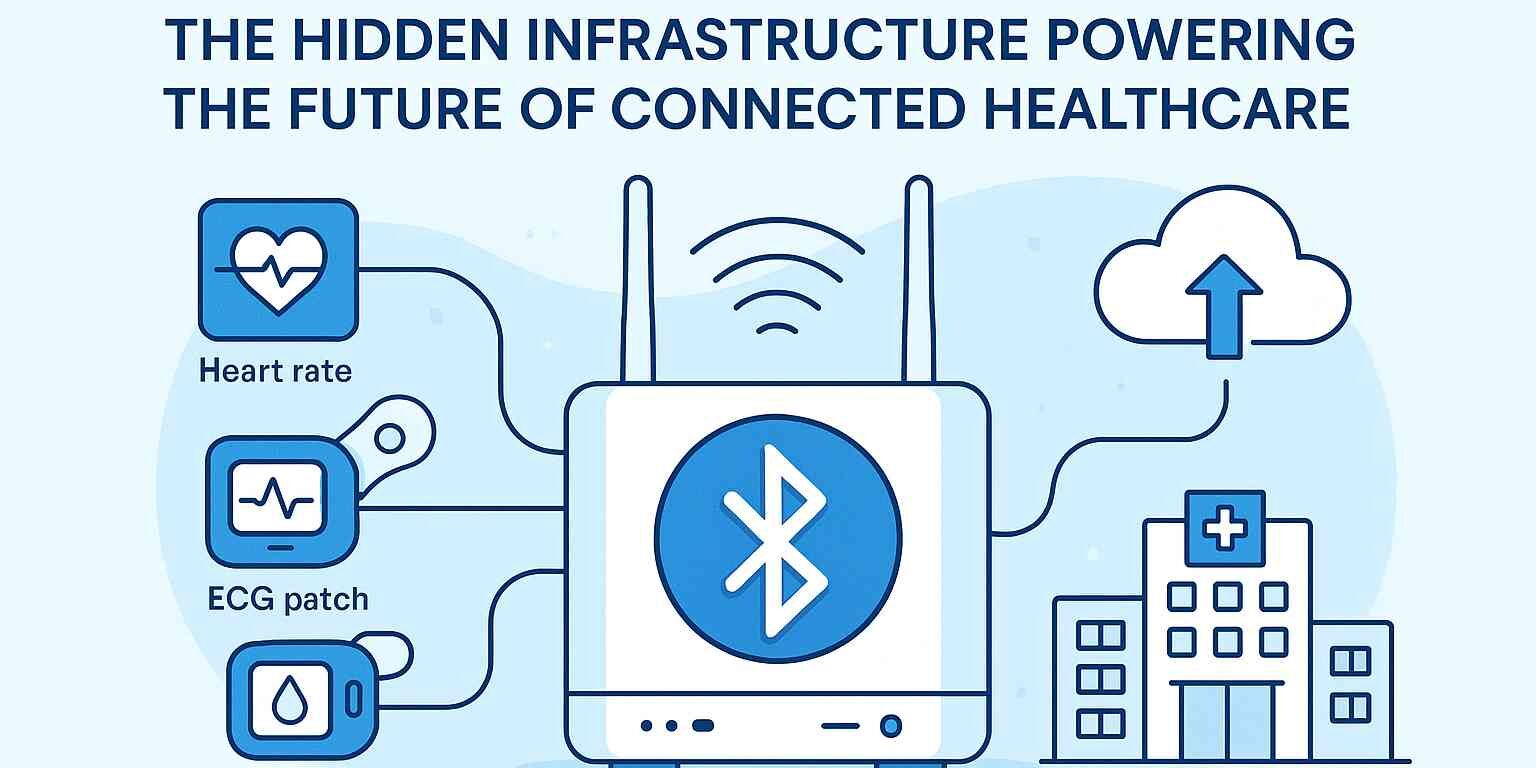In modern healthcare, data has become as critical as the medical devices gathering it. Whether it is real-time vital signs, long-term monitoring trends, or seamless device integration, reliable data transmission is essential for clinical decision-making and operational efficiency.
While 5G and Wi-Fi serve high-bandwidth hospital environments, Bluetooth has emerged as the backbone of short-range medical IoT. Its low power consumption, mature ecosystem, and stability make it the preferred choice for wearables, bedside sensors, and remote patient monitoring.
At the center of this shift is a crucial infrastructure component:
the Bluetooth gateway.
1. The Bluetooth Gateway: A Core Hub for Medical Data Flow
A Bluetooth gateway bridges Bluetooth-enabled medical devices with hospital networks or cloud systems. It collects data from devices such as ECG patches, glucose monitors, pulse oximeters, and digital stethoscopes, and transmits this data securely to HIS, EMR, or analytics platforms.
For healthcare organizations, this addresses one of the most persistent challenges in digital transformation:
removing device-level data silos and enabling a continuous flow from data acquisition to intelligent analytics.
Cassia’s long-range, multi-device Bluetooth gateway architecture allows healthcare providers to scale from a handful of devices to hundreds of endpoints per area—without redesigning existing infrastructure.

2. Why Healthcare Has a Rigid Need for Medical-Grade Gateways
Clinical environments demand far more than consumer-grade wireless performance. A gateway that drops packets, loses devices, or fails during interference events may compromise diagnostic accuracy or delay interventions.
A medical-grade Bluetooth gateway must deliver:
Strong data security
End-to-end encryption, access control, and authenticated communication protect sensitive patient information.
Zero-error transmission performance
Data interruptions or packet loss are unacceptable in use cases such as ECG monitoring, where a missing data segment can obscure signs of arrhythmia.
Healthcare-standard interoperability
Gateways must integrate seamlessly with HIS, EMR, middleware, and interoperability standards to be fully accepted within clinical workflows.
This is why healthcare facilities rely on infrastructure platforms such as the Cassia IoT Access Controller (AC) for mission-critical, scalable Bluetooth performance.
3. Transformative Application Scenarios for Bluetooth Gateways
Bluetooth gateways are driving measurable improvements across hospitals, outpatient environments, and home-care programs. The following three areas represent the most impactful use cases Cassia encounters in the field.
(1) Remote Home Health Monitoring
Bluetooth gateways enable chronic disease patients to automatically send real-time data from home-based medical devices to secure cloud platforms. This shift extends monitoring beyond hospital walls and provides clinicians visibility into intermittent, real-world health events that often occur outside clinical settings.
Key benefits include:
-
Reduced unnecessary hospital visits
-
Lower patient burden and costs
-
More timely and proactive treatment adjustments
-
Better long-term visibility into patient health trajectories
This is an area where Bluetooth-enabled wearables, paired with reliable gateways, deliver significant value.
(2) In-Hospital Smart Monitoring
In ICUs and general wards, Bluetooth gateways support centralized monitoring of multiple patients and device types. A single gateway network can collect ECG, SpO₂, respiratory data, and other vitals from dozens or hundreds of devices simultaneously.
For example, deployments using Cassia’s gateways allow clinical staff to remotely monitor patients across multiple departments, with real-time vitals and automated alerts for abnormal conditions. This reduces manual data checks and enhances response efficiency.
Key outcomes:
-
Improved clinician efficiency
-
Reduced monitoring workload
-
Better prioritization of urgent cases
-
More consistent and reliable vital-sign visibility
(3) IoT Upgrades for Legacy Medical Devices
Many hospitals maintain large inventories of legacy devices that lack connectivity. Bluetooth gateways offer a practical, cost-effective path to modernize these devices without full replacement.
Typical workflow:
-
Add a Bluetooth module to the existing device
-
Connect through a Bluetooth gateway
-
Stream data automatically into HIS or cloud analytics
This approach lowers digital transformation costs, preserves investments in existing equipment, and extends device utility.
4. Technical Requirements for a Medical-Grade Bluetooth Gateway
Healthcare environments introduce challenges such as high device density, RF interference, and strict uptime requirements. A high-performing medical-grade gateway must provide:
Advanced anti-interference capabilities
Optimized scanning and frequency management to mitigate 2.4 GHz interference from medical, industrial, and consumer devices.
Intelligent fault tolerance
Data buffering, retransmission, and autonomous recovery mechanisms ensure data completeness even when network interruptions occur.
Scalability across device types
Support for simultaneous connections spanning oximeters, ECG patches, infusion pumps, insulin delivery systems, and other devices.
These capabilities form the core of Cassia’s gateway design philosophy: long-range connectivity, multi-device scalability, and centralized control through the Cassia AC.
5. The Future: Fully Connected, Intelligent Healthcare Infrastructure
Bluetooth gateways are evolving rapidly as AI diagnostics, edge computing, and 5G backhaul become standard components of clinical technology stacks. As these technologies converge, Bluetooth gateways will play an increasingly strategic role by:
-
Enabling faster, analytics-driven insights
-
Supporting fully connected hospital ecosystems
-
Enhancing cross-facility data sharing
-
Powering scalable remote monitoring programs
-
Improving allocation of clinical resources
Bluetooth gateways are poised to become a foundational layer of the medical IoT ecosystem. As healthcare moves from digitization to intelligent automation, this infrastructure will help make high-quality, data-driven care accessible across hospitals, clinics, and home environments.
Cassia Networks remains committed to delivering the industry’s most reliable, secure, and scalable Bluetooth infrastructure—empowering healthcare providers to deliver better care, anywhere.
To learn more about how Cassia Networks is helping to shape the future of IoT in healthcare, reach out to sales@cassianetworks.com to get connected with our team members.








